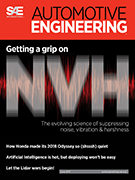Magazine

Automotive Engineering: April 7, 2015
2015-04-07
GM's CTO driving new paths to technology leadership 'We're making actual production commitments regarding our advanced-technology strategy, rather than just talking about it,' says GM's CTO Jon Lauckner. 'We're absolutely going to be among the leaders, if not the leader, in these areas.' Aluminum prepares for its next big leap Ford's F-Series blockbuster was just the beginning. New micromills now in pilot phase aim to bring vastly stronger and more formable light-alloy materials at higher capacity, says Alcoa's Mike Murphy. Slick solutions for friction reduction From new lubricants to 'smart' oil pumps and clever bearing technologies, engine designers are attacking every potential source of spin losses and internal friction in the quest for more mechanical work out of less fuel. Next-gen NSX: a twin-turbo, multi-material Ferrari-fighter The production NSX made its much-awaited global debut at NAIAS in January.










